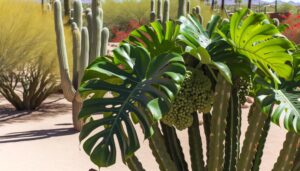Characteristics of Monstera Deliciosa Variegated Yellow Splash!
Monstera deliciosa ‘Variegated Yellow Splash‘ displays distinct variegation with irregular yellow and green sectors on fenestrated leaves. The chimeric mutation causing this variegation results in chlorophyll-deficient yellow pigmentation.
This epiphytic climber with significant leaf size variation requires bright, indirect light and well-draining soil rich in organic material. Ideal growth necessitates maintaining soil moisture without waterlogging and ensuring temperatures and humidity levels conducive to its tropical origins.
Fertilization with a balanced 20-20-20 N-P-K ratio and periodic pruning support health and aesthetics. For those interested, there are further details on its propagation and maintenance that can greatly enhance its cultivation.
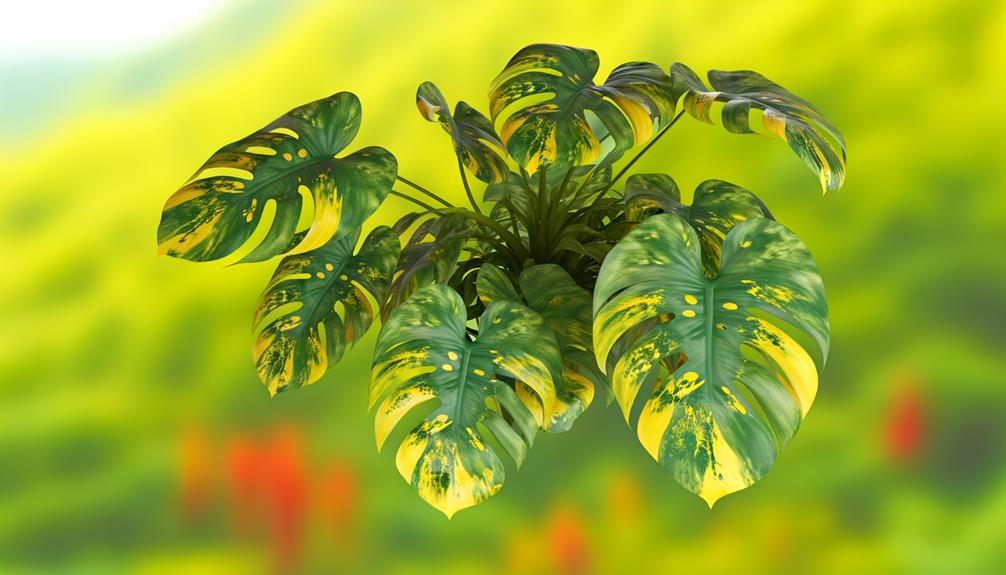
Key Takeaways
- Irregular yellow and green marbling on fenestrated leaves with varying patterns.
- Significant leaf size variation, reaching up to 90 cm.
- Thrives in bright, indirect light; direct sunlight can cause leaf burn.
- Requires well-draining soil rich in organic material and consistent moisture without waterlogging.
- Maintain high humidity levels (60-80%) for optimal growth.
Unique Variegation Patterns
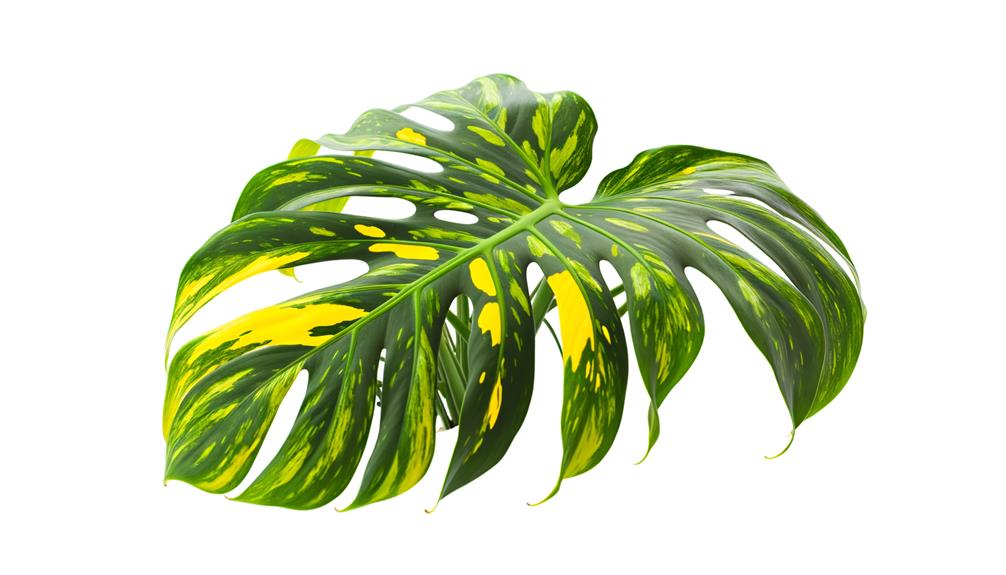
Monstera deliciosa ‘Variegated Yellow Splash’ displays a unique variegation pattern characterized by irregular yellow and green marbling on its fenestrated leaves.
The variegation appears as asymmetric splashes of chlorophyll-deficient sectors juxtaposed against the chlorophyll-rich regions, creating a visually striking contrast.
This pattern of variegation is not uniform; rather, it varies considerably from leaf to leaf, contributing to the plant’s distinctive aesthetic appeal.
The fenestrations, or natural leaf perforations, further enhance this visual complexity by introducing additional light interplay.
The genetic basis for this variegation lies in a chimeric mutation, where sectors of the plant tissue lack chloroplasts, resulting in the yellow pigmentation.
This mutation is typically somatic, arising from meristematic cell divisions, influencing the overall morphology and appearance.
Growth Habits
Monstera deliciosa variegated yellow splash exhibits significant variation in leaf size, with mature leaves reaching up to 90 cm in length under ideal conditions.
This cultivar is an epiphytic climber, relying on adventitious roots to anchor itself to trees or artificial supports.
The species demonstrates robust vertical growth when provided with a suitable trellis or moss pole, facilitating its natural climbing behavior.
Leaf Size Variation
How does the variegated yellow splash phenotype influence the leaf size variation and growth habits in *Monstera deliciosa*?
The variegation, characterized by irregular yellow patterns on the foliage, impacts photosynthetic efficiency, subsequently affecting leaf size. Reduced chlorophyll content due to variegation results in diminished photosynthetic capacity, leading to smaller leaves compared to fully green counterparts.
*Monstera deliciosa* with the variegated yellow splash phenotype typically exhibit slower growth rates. The energy allocation within the plant prioritizes maintaining variegation, which further restricts leaf expansion.
Additionally, environmental factors such as light intensity and nutrient availability interact with the variegation to modulate leaf size variation. These growth habits underscore the delicate balance between aesthetic appeal and physiological efficiency in variegated *Monstera deliciosa* specimens.
Climbing and Support
In addition to impacting leaf size and growth rates, the variegated yellow splash phenotype also influences the climbing and support mechanisms of *Monstera deliciosa*, necessitating specific structural adaptations to enhance vertical growth.
This cultivar exhibits enhanced aerial root development, which facilitates its epiphytic climbing nature. These adventitious roots adhere to substrates, such as tree trunks or moss poles, providing stability and access to nutrients.
The variegated sections, containing less chlorophyll, may require more robust support structures to counterbalance potential weakness in photosynthetic efficiency. Ideal growth conditions include high humidity and indirect light, which promote vigorous root and stem elongation.
Implementing trellises or vertical supports can greatly improve structural integrity and overall plant health, ensuring balanced and sustained growth.
Light Requirements
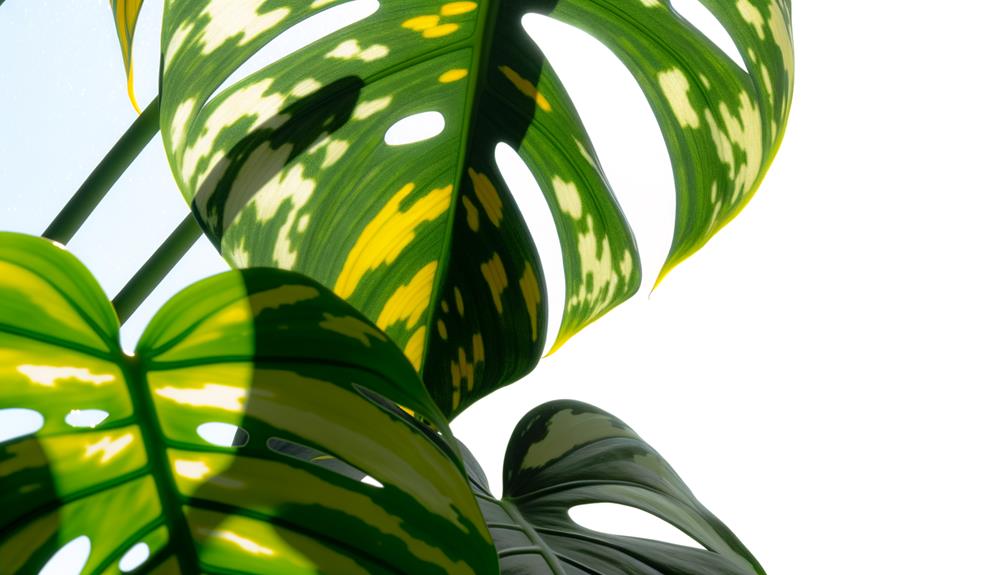
Variegated Yellow Splash Monstera deliciosa thrives best under bright, indirect light, which promotes the maintenance of its distinctive variegation patterns. Direct sunlight can cause leaf burn and diminish the vibrancy of the variegation. Optimal light conditions are essential for photosynthesis, impacting the plant’s overall health and growth rate.
Key light requirements include:
- Intensity: Bright but filtered light, typically achieved by placing the plant near an east or west-facing window.
- Duration: Approximately 10-12 hours of light exposure daily to support robust growth.
- Avoidance of Direct Sunlight: Direct rays can cause chlorophyll degradation, resulting in leaf scorch.
- Artificial Lighting: In low-light environments, full-spectrum grow lights can be used to replicate natural light conditions.
These conditions guarantee that the Monstera deliciosa maintains its variegated beauty and structural integrity.
Watering Needs
Monstera deliciosa variegated ‘Yellow Splash’ requires careful watering schedules to maintain ideal growth and health.
The frequency of watering should be adjusted based on soil moisture levels, ensuring the substrate remains consistently moist but not waterlogged.
Proper drainage is essential, as poorly drained soil can lead to root rot and other physiological issues.
Frequency of Watering
Perfect hydration for Monstera deliciosa ‘Variegated Yellow Splash’ demands a careful balance, wherein the substrate remains consistently moist but never waterlogged. To achieve this, understanding the frequency of watering is vital. Factors influencing watering frequency include ambient humidity, temperature, and the plant’s growth phase.
Here are four guidelines to determine best watering intervals:
- Assess Soil Moisture: Check moisture levels approximately 2 inches below the surface before watering.
- Seasonal Adjustments: Water more frequently during the active growing season (spring and summer) and reduce in dormancy periods (fall and winter).
- Environmental Conditions: Increase watering frequency in higher temperatures and lower humidity.
- Plant Size and Pot Type: Larger plants and those in porous pots like terracotta may require more frequent watering.
These practices ensure peak hydration for vigorous growth.
Soil Moisture Levels
Maintaining ideal soil moisture levels is fundamental to meeting the watering needs of Monstera deliciosa ‘Variegated Yellow Splash’, ensuring the substrate remains uniformly damp without becoming saturated.
The plant thrives in a consistently moist environment, which supports its physiological processes including transpiration and nutrient uptake. Excess water can lead to anaerobic conditions, promoting root rot caused by pathogens such as Pythium spp.
Conversely, insufficient moisture can cause wilting and impede photosynthesis, leading to chlorosis and stunted growth. Employing a balanced watering regimen, ideally utilizing a hygrometer to measure soil moisture content, is recommended.
The substrate should feel slightly moist to the touch, resembling the consistency of a wrung-out sponge, to maintain the best plant health and vigor.
Drainage Requirements
Maintaining proper drainage is crucial for preventing waterlogged conditions that can result in root rot in Monstera deliciosa ‘Variegated Yellow Splash’. The plant requires a controlled water environment to sustain peak root health and overall vigor.
To achieve this, consider the following:
- Soil Composition: Use a well-draining potting mix containing perlite, orchid bark, and peat to improve aeration and water drainage.
- Pot Selection: Choose containers with sufficient drainage holes to facilitate the removal of excess water.
- Watering Practices: Allow the top 2-3 inches of soil to dry out between waterings to avoid oversaturation.
- Environmental Considerations: Maintain humidity levels around 60-70%, while preventing excessive moisture accumulation.
Following these recommendations guarantees that Monstera deliciosa ‘Variegated Yellow Splash’ thrives without the danger of root-related diseases.
Soil Preferences

For ideal growth, Monstera deliciosa variegated yellow splash requires well-draining soil rich in organic material and slightly acidic to neutral pH levels, ideally between 5.5 and 7.
The substrate should be a mixture of peat moss, perlite, and pine bark to ensure aeration while retaining sufficient moisture. The presence of organic material such as compost or worm castings enhances nutrient availability, fostering strong root development.
A loamy soil texture is preferred, facilitating root penetration and reducing waterlogging risks. Regular monitoring of soil pH and nutrient content is crucial to maintain prime conditions.
Incorporating mycorrhizal fungi can further support root health and nutrient uptake, promoting overall plant vigor and variegation intensity in Monstera deliciosa variegated yellow splash.
Humidity Levels
In addition to soil preferences, Monstera deliciosa variegated yellow splash thrives in environments with high humidity levels, ideally between 60% and 80%, to replicate its natural tropical habitat. High humidity is essential for maintaining the turgor pressure within the plant cells, reducing transpiration stress, and promoting lush foliage.
To achieve ideal humidity conditions, consider the following strategies:
- Use a Humidifier: Place a humidifier near the plant to maintain consistent humidity levels.
- Grouping Plants: Cluster multiple tropical plants together to create a microenvironment with elevated humidity.
- Misting: Regularly mist the leaves with distilled water to increase ambient moisture.
- Humidity Trays: Place the plant on a tray filled with water and pebbles to facilitate evaporation and enhance local humidity.
Fertilization Tips

Proper fertilization of Monstera deliciosa variegated yellow splash is essential for supporting its vigorous growth and maintaining the striking variegation patterns on its foliage.
Utilize a balanced, water-soluble fertilizer with an N-P-K ratio of 20-20-20 to guarantee an even distribution of essential macro-nutrients. Application should occur bi-monthly during the growing season, typically spring through early autumn. For best absorption, dilute the fertilizer to half the recommended strength to prevent root burn.
Micronutrients such as magnesium (Mg) and iron (Fe) are critical for sustaining the vivid chlorophyll production and vibrant yellow splashes. Incorporate organic matter like compost or well-decomposed manure to enhance soil microbial activity, which aids in nutrient uptake.
Avoid over-fertilization, as it can disrupt the plant’s natural growth rhythm.
Pruning Techniques
Effective trimming of Monstera deliciosa variegated yellow splash involves strategic removal of specific foliage to promote ideal light penetration and air circulation, thereby enhancing overall plant health and variegation. Trimming not only fosters growth but also maintains the aesthetic appeal of the plant.
Key steps for effective trimming include:
- Sanitize Tools: Use sterilized trimming shears to prevent disease transmission.
- Target Older Leaves: Remove senescent or damaged leaves to redirect energy to new growth.
- Cut Above Nodes: Make precise cuts just above a node to encourage branching.
- Monitor Variegation: Trim non-variegated sections to maintain the unique yellow splash pattern.
These measures guarantee the Monstera maintains its vibrant variegation and robust growth.
Propagation Methods
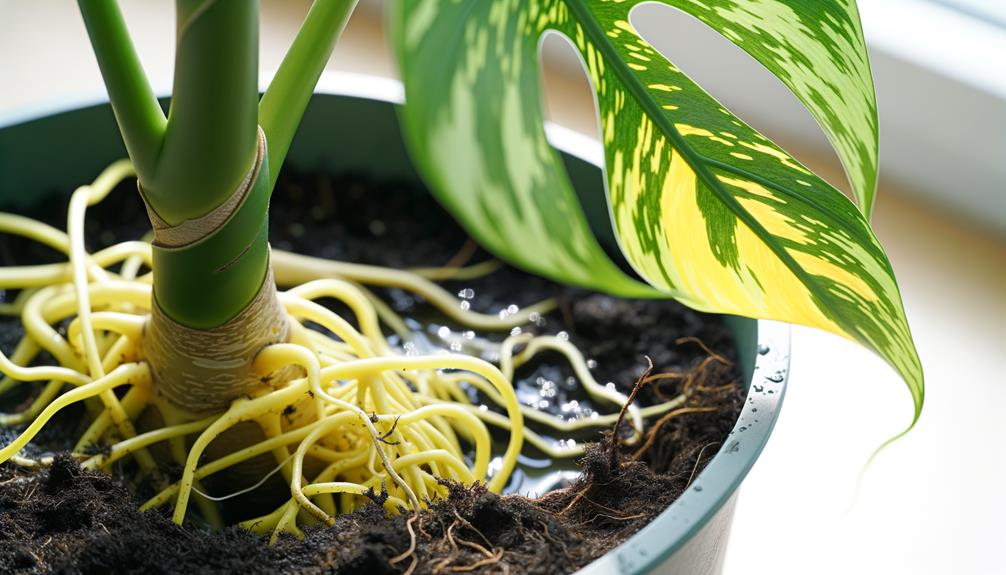
Propagation of Monstera deliciosa variegated yellow splash mainly employs stem cuttings to maintain the preservation of its unique variegated characteristics. This method involves selecting a healthy, mature stem with at least one node and an aerial root.
Using a sterilized cutting tool, make a clean incision just below the node. The cutting should then be allowed to callus for 24 hours to prevent rot.
Subsequently, the callused cutting can be placed in water or a well-draining substrate such as a mix of perlite and sphagnum moss. Maintain high humidity and indirect light conditions to facilitate root development.
Monitoring for new growth will indicate successful propagation, ensuring the variegated traits are preserved in subsequent generations.
Common Pests
Monstera deliciosa variegated yellow splash is susceptible to various phytophagous pests. Common pests include spider mites (Tetranychus urticae), aphids (Aphidoidea), and mealybugs (Pseudococcidae). Identifying the presence of these pests early is essential for maintaining plant health. Common signs of infestation include webbing, honeydew secretion, and chlorotic spots on foliage.
Implementing preventive measures is crucial. Regular inspection and maintaining optimal humidity levels are key practices. Employing natural pest remedies like neem oil can effectively mitigate infestations.
Identifying Common Pests
Identifying common pests that afflict Monstera deliciosa variegated yellow splash involves recognizing signs of infestations by arthropods such as spider mites (Tetranychus urticae), mealybugs (Pseudococcidae), and scale insects (Coccoidea). These pests can cause significant damage through feeding activities, leading to visible symptoms such as yellowing leaves, stunted growth, and honeydew excretion.
Specific indicators of infestations include:
- Spider Mites (Tetranychus urticae): Fine webbing on leaf undersides, stippling or speckling on foliage.
- Mealybugs (Pseudococcidae): White, cotton-like masses on stems and leaf axils, honeydew, and sooty mold.
- Scale Insects (Coccoidea): Hard, shell-like coverings on stems and leaves, chlorotic spots.
- Thrips (Thysanoptera): Silvery streaks on leaves, black fecal spots.
Understanding these signs is essential for effective management and maintaining plant health.
Preventive Measures
To effectively prevent infestations of common pests such as Tetranychus urticae, Pseudococcidae, and Coccoidea on Monstera deliciosa variegated yellow splash, it is crucial to implement an integrated pest management (IPM) strategy that includes regular monitoring, cultural practices, and biological controls.
Regularly inspect foliage for early signs of pest activity, such as webbing, sooty mold, or honeydew excretions. Maintain optimal humidity and airflow to deter Tetranychus urticae (spider mites), which thrive in dry conditions.
Employ cultural practices like removing debris and pruning infested leaves to reduce pest habitat. Introduce predatory insects such as Phytoseiulus persimilis for biological control, targeting specific pests without harming the plant.
This multi-faceted approach ensures effective protection.
Natural Pest Remedies
Employing natural pest remedies can effectively manage common pests on Monstera deliciosa variegated yellow splash without resorting to synthetic chemicals. Common pests such as aphids (Aphidoidea), spider mites (Tetranychidae), and scale insects (Coccoidea) can severely impact the health of the plant.
Natural methods can mitigate these issues through biological and mechanical means:
- Neem Oil (Azadirachta indica): Acts as an insect repellent and disrupts pest life cycles.
- Insecticidal Soap: Effectively targets soft-bodied pests like aphids by disrupting cell membranes.
- Ladybugs (Coccinellidae): Predatory insects that naturally control aphid populations.
- Manual Removal: Using water sprays or handpicking to physically remove pests from foliage.
These methods safeguard the health of Monstera deliciosa variegated yellow splash in an eco-friendly manner.
Maintaining Variegation
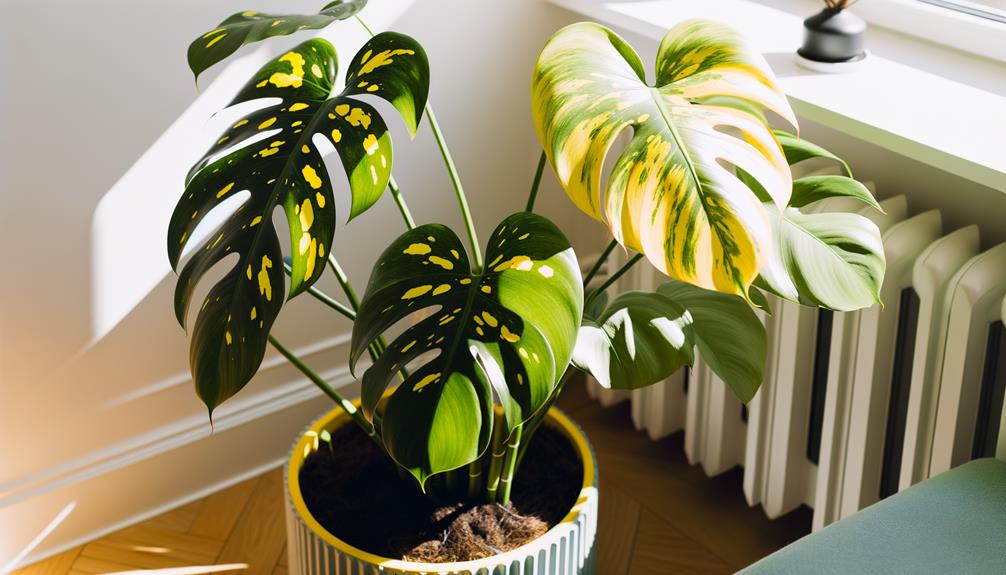
Consistently maintaining the variegation in Monstera deliciosa ‘Variegata’ requires careful manipulation of light exposure, nutrient balance, and pruning techniques. Best variegation is achieved by providing bright, indirect light, as excessive direct sunlight can cause leaf burn, while insufficient light may lead to reversion to green foliage.
Nutrient balance is critical; a balanced fertilizer with a 20-20-20 N-P-K ratio is recommended, avoiding excessive nitrogen which may promote greener growth.
Pruning involves selectively removing non-variegated leaves and stems to encourage the propagation of variegated sections. Regularly inspect the plant for signs of reversion, and promptly address any changes by adjusting light and nutrient conditions.
Consistent monitoring and adjustments are essential for maintaining the aesthetic appeal of Monstera deliciosa ‘Variegata’.
Conclusion
To sum up, Monstera deliciosa ‘Variegated Yellow Splash‘ embodies unique variegation patterns and specific growth habits that require precise light, water, and soil conditions.
Effective pruning and propagation techniques, along with diligent pest management, are essential to maintain its variegation.
Managing these demands can be intricate, yet the plant’s aesthetic rewards make the effort worthwhile.
This cultivar is not just a plant but a tribute to horticultural artistry, proving that the devil is in the details when cultivating such botanical marvels.




